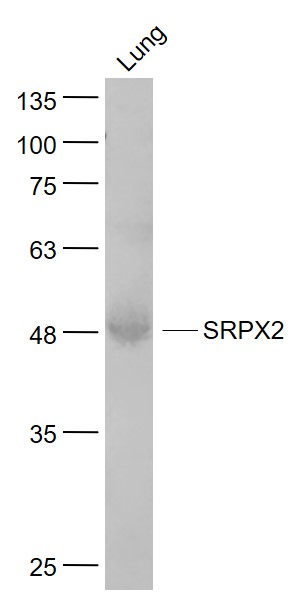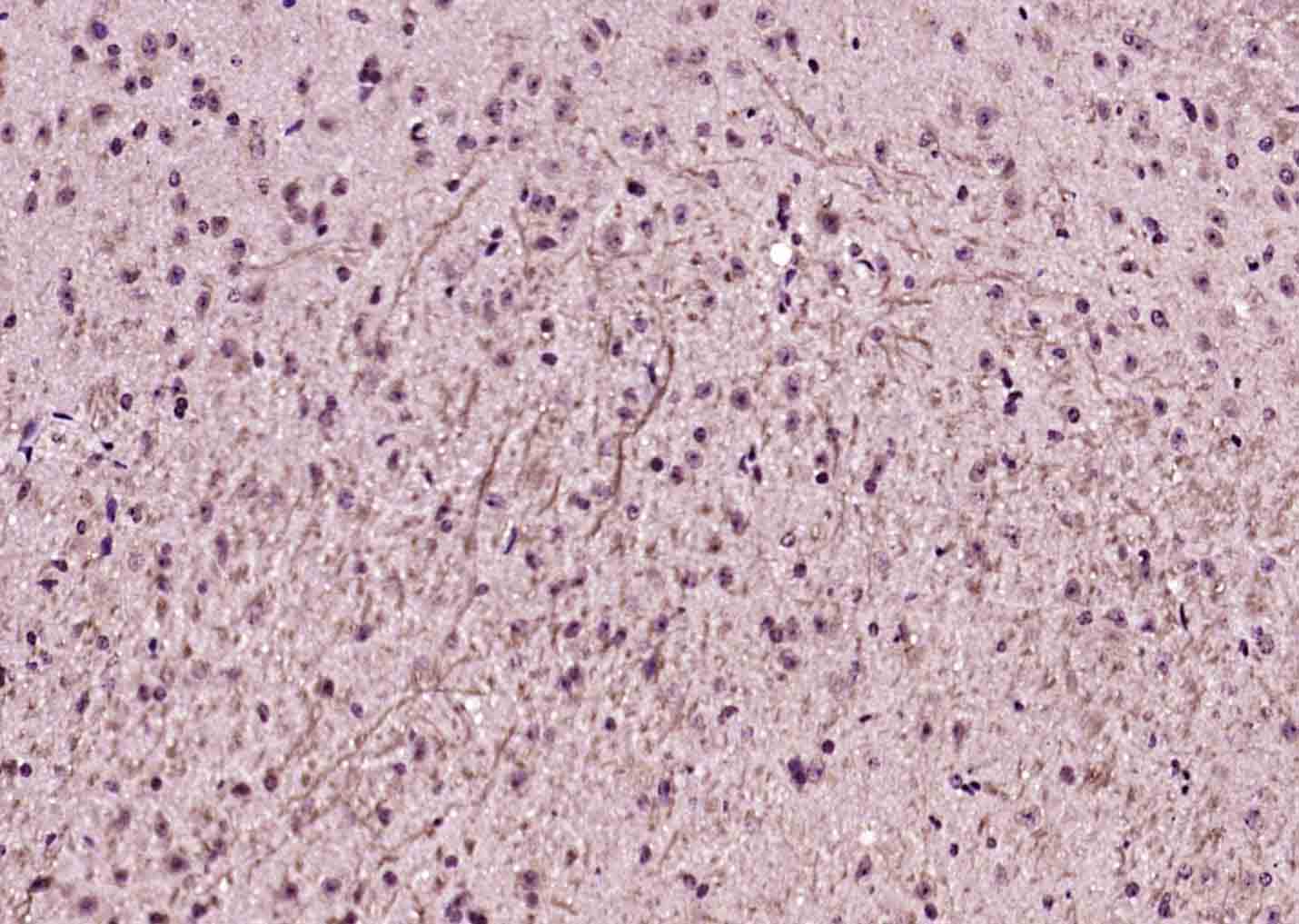SRPX2 Rabbit pAb
SRPX2 Rabbit pAb
- 产品详情
- 实验流程
- 背景知识
Application
| WB, IHC-P, IHC-F, IF |
|---|---|
| Primary Accession | O60687 |
| Reactivity | Mouse |
| Predicted | Human, Rat |
| Host | Rabbit |
| Clonality | Polyclonal |
| Calculated MW | 52972 Da |
| Physical State | Liquid |
| Immunogen | KLH conjugated synthetic peptide derived from human SRPX2 |
| Epitope Specificity | 121-220/465 |
| Isotype | IgG |
| Purity | affinity purified by Protein A |
| Buffer | 0.01M TBS (pH7.4) with 1% BSA, 0.02% Proclin300 and 50% Glycerol. |
| SUBCELLULAR LOCATION | Cytoplasm. Secreted. |
| SIMILARITY | Contains 1 HYR domain. Contains 3 Sushi (CCP/SCR) domains. |
| SUBUNIT | Interacts with ADAMTS4, CTSB and PLAUR. Interacts with PLAUR (via the UPAR/Ly6 domains). |
| DISEASE | Defects in SRPX2 are a cause of bilateral perisylvian polymicrogyria (BPP) [MIM:300388]. BPP is the most common form of polymicrogyria, a malformation of the cortex, in which the brain surface is irregular and the normal gyral pattern replaced by multiple small, partly fused, gyri separated by shallow sulci. BPP results in mild mental retardation, epilepsy and pseudobulbar palsy, causing difficulties with expressive speech and feeding. Defects in SRPX2 are a cause of rolandic epilepsy with speech dyspraxia and mental retardation X-linked (RESDX) [MIM:300643]. A condition characterized by the association of rolandic seizures with oral and speech dyspraxia, and mental retardation. Rolandic occur during a period of significant brain maturation. During this time, dysfunction of neural network activities such as focal discharges may be associated with specific developmental disabilities resulting in specific cognitive impairments of language, visuo-spatial abilities or attention. |
| Important Note | This product as supplied is intended for research use only, not for use in human, therapeutic or diagnostic applications. |
| Background Descriptions | SRPX2 is a 465 amino acid secreted protein expressed in neurons of the brain, including the rolandic area. It has been suggested that SRPX2 enhances cell motility, migration and adhesion through FAK signaling in gastric and other cancer cells. Localized to the cytoplasm, SRPX2 is a ligand for uPAR (urokinase plasminogen activator), a receptor that is a crucial component of the extracellular plasminogen proteolysis system. SRPX2 may be responsible for rolandic seizures (RSs) associated with oral and speech dyspraxia and mental retardation (MR). The involvement of SRPX2 in these disorders suggests an important role for SRPX2 in the perisylvian region critical for language and cognitive development. |
| Gene ID | 27286 |
|---|---|
| Other Names | Sushi repeat-containing protein SRPX2, Sushi-repeat protein upregulated in leukemia, SRPX2, SRPUL |
| Target/Specificity | Expressed in neurons of the rolandic area of the brain (at protein level). Highly expressed in the brain, placenta, lung, trachea, uterus and adrenal gland. Weakly expressed in the peripheral blood, brain and bone marrow. Expressed in numerous cancer cell lines. |
| Dilution | WB=1:500-2000,IHC-P=1:100-500,IHC-F=1:100-500,IF=1:100-500 |
| Storage | Store at -20 °C for one year. Avoid repeated freeze/thaw cycles. When reconstituted in sterile pH 7.4 0.01M PBS or diluent of antibody the antibody is stable for at least two weeks at 2-4 °C. |
| Name | SRPX2 |
|---|---|
| Synonyms | SRPUL |
| Function | Acts as a ligand for the urokinase plasminogen activator surface receptor. Plays a role in angiogenesis by inducing endothelial cell migration and the formation of vascular network (cords). Involved in cellular migration and adhesion. Increases the phosphorylation levels of FAK. Interacts with and increases the mitogenic activity of HGF. Promotes synapse formation. May have a role in the perisylvian region, critical for language and cognitive development. |
| Cellular Location | Secreted. Cytoplasm. Cell surface. Synapse |
| Tissue Location | Expressed in neurons of the rolandic area of the brain (at protein level). Highly expressed in the brain, placenta, lung, trachea, uterus, adrenal gland, heart, ovary and placenta. Weakly expressed in the peripheral blood, brain and bone marrow. Expressed in numerous cancer cell lines and in gastrointestinal cancer cells. Higher levels found in colorectal cancers than in normal colonic mucosa |
For Research Use Only. Not For Use In Diagnostic Procedures.
Provided below are standard protocols that you may find useful for product applications.
BACKGROUND
SRPX2 is a 465 amino acid secreted protein expressed in neurons of the brain, including the rolandic area. It has been suggested that SRPX2 enhances cell motility, migration and adhesion through FAK signaling in gastric and other cancer cells. Localized to the cytoplasm, SRPX2 is a ligand for uPAR (urokinase plasminogen activator), a receptor that is a crucial component of the extracellular plasminogen proteolysis system. SRPX2 may be responsible for rolandic seizures (RSs) associated with oral and speech dyspraxia and mental retardation (MR). The involvement of SRPX2 in these disorders suggests an important role for SRPX2 in the perisylvian region critical for language and cognitive development.
终于等到您。ABCEPTA(百远生物)抗体产品。
点击下方“我要评价 ”按钮提交您的反馈信息,您的反馈和评价是我们最宝贵的财富之一,
我们将在1-3个工作日内处理您的反馈信息。
如有疑问,联系:0512-88856768 tech-china@abcepta.com.























 癌症的基本特征包括细胞增殖、血管生成、迁移、凋亡逃避机制和细胞永生等。找到癌症发生过程中这些通路的关键标记物和对应的抗体用于检测至关重要。
癌症的基本特征包括细胞增殖、血管生成、迁移、凋亡逃避机制和细胞永生等。找到癌症发生过程中这些通路的关键标记物和对应的抗体用于检测至关重要。 为您推荐一个泛素化位点预测神器——泛素化分析工具,可以为您的蛋白的泛素化位点作出预测和评分。
为您推荐一个泛素化位点预测神器——泛素化分析工具,可以为您的蛋白的泛素化位点作出预测和评分。 细胞自噬受体图形绘图工具为你的蛋白的细胞受体结合位点作出预测和评分,识别结合到自噬通路中的蛋白是非常重要的,便于让我们理解自噬在正常生理、病理过程中的作用,如发育、细胞分化、神经退化性疾病、压力条件下、感染和癌症。
细胞自噬受体图形绘图工具为你的蛋白的细胞受体结合位点作出预测和评分,识别结合到自噬通路中的蛋白是非常重要的,便于让我们理解自噬在正常生理、病理过程中的作用,如发育、细胞分化、神经退化性疾病、压力条件下、感染和癌症。







